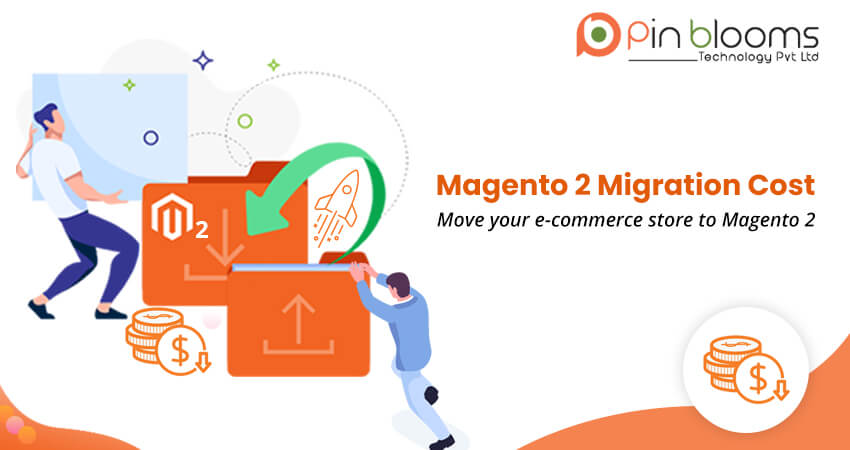Today, Magento is one of the top leading eCommerce platforms that provide the best solutions for ecommerce businesses. With time, your online business needs to expand significantly to meet the requirements of all the customers. So, you need to integrate more advanced features, but your current platform does not support these. Therefore, the merchants are looking for the Magento 2 migration cost for their online store.
Are you still running Magento 1.x store? You really need to know about the benefits of Magento 2 for ecommerce businesses. It delivers modern, scalable, and reliable ecommerce solutions along with countless customizations for your online business. In this blog, you will know about the factors that are responsible for Magento 2 migration cost. Moreover, we will cover the reasons for migration to Magento 2 and the migration process here.
Migrate To Magento 2: Why should you move your e-commerce store to Magento 2?
Nowadays, every ecommerce business owner wants to migrate their online store into Magento 2.x store. But, is it beneficial to upgrade your store at this time? I know you all are looking for this answer.
Here is a list of benefits of Magento 2 for ecommerce development. These are the reasons that will tell you why Magento migration is necessary.
Superior Performance
Magento is one of the best ecommerce platforms that provide superior performance by reducing page loading time and other statistical operations. It includes thousands of extensions for customization purposes. By integrating the best extensions in your e-commerce store, you will make your store unique from other websites.
Multiple Payment Alternatives
Usually, e-commerce sites provide multiple payment options to increase the customer satisfaction rate. It allows the customers to make payments with the available payment options. Magento supports all the popular payment gateways, such as PayPal, Google Checkout, Authorize.net, bank transfer, cash on delivery, and many more.
SEO-friendly Platform
Magento 2 is powered with SEO-friendly features that boost your sites such as rich snippets on the catalog page, URL Structure, sitemaps, image optimization, canonical tags for categories & products, and many more. By integrating SEO extensions and plugins will make your site more user-friendly as well as crawlable by Google bots.
Better Customer Experience
Magento 2 is one of the best e-commerce platforms in terms of customer experience. Better performance, security, streamlined checkout, and responsiveness are the features of Magento that allow the customers to find the products from the store.
Database Segmentation
Magento 2 has split the database structure into 3 categories:- Product data, Checkout, Orders. This database segmentation avoids the database overload so that the frontend customer user experience is not affected. Additionally, individual segmentation has not any worse effect on others.
Easy Admin Panel
Magento 2 provides a better admin panel than other e-commerce platforms. Now, setting new products becomes so easy with product creation tools. With the drag and drop functionalities, the admin can modify the online store’s appearance and layout by themselves. Moreover, users can customize the admin panel for better data management of customers, products, and orders to increase efficiency.
Integration with third-party components
Magento allows the site admin and developers to integrate third-party services according to the business requirement. It basically reduces the burden on the development as well as the deployment team. You can connect any application or plugin with Magento’s extensible API without any problem.
Multiple e-Stores Management
Integrating more features and functionalities in the eCommerce website to gain more customer reach, which can be easily fulfilled in Magento. All big companies choose the Magento e-commerce platform that allows to build and manage multi-store strategies from a single dashboard.
Read More:- How Much does it cost to develop a Magento e-commerce store?
Magento 2 – An Overview of Powerful Upgraded Magento Version
Magento 2 becomes one of the best choices for most E-Commerce store owners. It brings endless customization as well as capabilities possibilities for your online business. Magento is an open-source platform that is known for its well-deserved reputation. It successfully helps the merchants to serve millions of customers every day with its strong scalability, high customizability, and powerfully built-in features.
Magento has introduced multiple versions and product updates in 2007. It offers two versions Magento Open Source and Magento Commerce that deliver the best eCommerce solutions. Additionally, you will get more outstanding features as compared to the other ones. The Magento 2 migration process requires experienced Magento developers.
How much does it cost to migrate to Magento 2?
Pre Magento 2 Migration Cost Checklists
Here is a list of Magento migration checklist that helps you to take care before migrating from Magento 1 to Magento 2:
- Before migrating, take a complete backup of your e-commerce stores such as all the files, folders, and databases.
- Build a clone of your e-commerce store. Make sure that do not use the live website for the Magento migration process.
- Analyze the store completely. Delete the unnecessary for the Magento 2.x migration.
- Make sure that the current theme, extensions, and custom code are compatible or not. Check all the factors.
- Delete all the useless data like logs, recently viewed products, compared products, and many more from the database.
- Install a fresh copy of Magento 2.x on the same hosting server where you put your Magento 1.x.
- It will help you to make the Magento migration process with ease as much as possible.
- Before going to move your e-commerce to Magento 2.x migration process, make sure that the store traffic and other SEO practices are streamlined.
Let’s look at each part that is responsible for Magento 2 migration cost
During the Magento 2 migration, you need to move all the data from your existing store to Magento 2. Therefore, the Magento migration process is divided into few stages, so that all the data is transferred successfully.
Let us look at each factor to better understand for Magento 2 migration cost:-
Design/Theme Migration
Magento 2 introduces the best-customized theme that delivers an enhanced shopping experience. Developers can create an attractive, user-friendly, and responsive theme for your Magento 2 store. Also, you can modify the current theme to make it compatible with the latest Magento 2 version. Moreover, you can purchase the Magento 2.x theme from the Magento Marketplace or reputed sources. The eye-catching theme will help you to enhance the user experience for your e-commerce store.
Cost:- Designing a new e-commerce website takes approximately 80 hours to 200 hours. It includes everything from designing or purchasing the theme to the development and approval for mobile and tablet versions. Therefore, developing the store design will cost you approximately between $1500 and $20,000.
Extension Migration
Extensions are the most essential part of the Magento migration process. It will take roughly take 2-4 weeks. Therefore, you can pick the right extensions from the marketplace for your store. Before going to purchase, make sure that they are compatible with the latest Magento 2.x and work well together.
If there is no extension according to the functionality of your store, the development team has to create a new custom extension. It will take more time to create a complex feature for your store. After that, test your custom extension for bugs and compatibility issues. Likewise, backend work also contains developing custom extensions, integrations, customization, and many more.
Cost:- Extension migration will be highly dependent on the complexity of your store functions. So, the average cost of extension migration work will be between $10,000 and 100,000.
Read more:- Boost Your E-Commerce Sales with Best Magento 2 Extensions
Customization
Usually, in many cases, the custom code of Magento 1.x store is compatible with the Magento 2.x. By using the Code Migration Tool, the developers can customize the code of Magento 1 to Magento 2. But, there are differences in both platforms, so the Magento migration process may need some additional work to integrate the custom code into the Magento 2.x store successfully.
Cost:- The overall price of custom function migration is going around $1000 to $3000. It will also depend on the requirement of the store.
Data Migration
Data migration is a process of shifting the old data to the Magento 2.x. There is a list of 5 main entities that need to move in this process:-
- Customer accounts
- Product information
- Data about orders
- Store configuration
- Extension custom data
Magento offers the Data Migration Tool to make the process go faster. Because it is not easy to copy all the data from one place to another. So, this tool will help the developers to migrate the store data such as customer, product, promotions, settings, and configuration using CLI commands. The Magento 1 to Magento 2 migration tool have limited capabilities to migrate the specific data forms.
Usually, a lot of manual work is involved in the migration of extensions, themes, other custom codes of Magento 1.x store. Because it can not migrate all the data automatically. Therefore, this phase needs a detailed migration plan to better understand the platform and processes.
Cost:- There are two ways to charge for data migration. First, the overall cost is based on the amount of data migrated. It is more beneficial for small companies as well as start-ups with a small amount for data migration. Secondly, you can charge your merchants at a fixed price cost. It will be going to cost you around $5000 to $15,000.
Go Live and Post Release Support
This is the last step that shows Magento 2.x store is ready with more security, performance optimization, extended bug fixing, new extensions, and many more.
Read More:- Magento 2.4.3 Release Notes and Updates About Latest Magento 2 Version
Steps to Follow for Magento 2 Migration Cost
We already have discussed on Magento 2 migration cost. Let us see the Magento Migration Process, which is divided into eight major steps. You need to follow these steps in order to complete the migration process.
Step 1:- Analysis of Extension
First, you need to analyze the Magento 1.x modules. Because they are not compatible with Magento 2. Find out the plugins that you do not need anymore. You need to research what your Magento 2.x really needs. After that, make a list of all the extra features that you want to integrate into your Magento 2.x store.
Step 2:- Database replication
You should make a copy of all your data, such as customer details, product details, product categories, passwords, orders, reviews, etc.
Step 3:- Data Migration
Now, it is time to transfer all the data to your new Magento 2.x store. Here, the Magento data migration tool is used to complete the data migration process. Before migrating the data, keep in mind that extensions, themes, media files, admin privileges, and technical customization will not be migrated automatically.
Step 4:- Transfer theme and images
You can create a new design for Magento 2.x store or purchase a customized and user-friendly theme from the marketplace. It will take the same amount of time. Focus on all the visual improvements that you want to build with the updated industry standards and best practices.
Step 5:- Find new extensions
You can purchase the right extensions from the marketplace according to the functionality of your Magento 2.x store. Moreover, if your store relies on some specific functionality, develop a new custom extension from scratch.
Step 6:- Testing & Quality Assurance
Now, you have a complete working new website in the Magento migration process. So, you need a specialized QA team to review every feature and functionality of your Magento 2.x store. Along with this, perform cross-browser and cross-device testing to make sure that everything is working properly or not. If any issue occurs during the testing phase, they are forwarded to Magento 2 developers for improvement.
Step 7:- Magento 2.x store launch
Before launching the Magento 2 store, you need to perform some tasks such as activate payment gateways, check the structural layout of URLs to avoid SEO issues, and test the live domain. If everything is perfect according to you, then you have successfully migrated your Magento 1.x store.
Step 8:- Ongoing development & support
If you think that your work is done after the completion of Magento 2 migration, then you are wrong. You need to collect the customer reviews and use this information to improve your website performance and functionality. An e-commerce website development is a continuous process, until then your site is up and running.
Hire a professional Magento development team
Despite this, we have described the common steps for Magento 1 to Magento 2 migration cost. But according to our expertise, the Magento migration process could be slightly different even your e-commerce website is built on the same platform. The reason behind this, every business is unique and has different requirements of online shop functionality for migration.
Talk to our Magento expert who can assist you with Magento 1 Magento 2 migration services without affecting your current site. Furthermore, our certified developers have in-depth knowledge in creating Magento 2 website development that will enhance your business worldwide. As a top leading Magento development company, we deliver high-quality results in due time as well as also available to support your store after its release.










